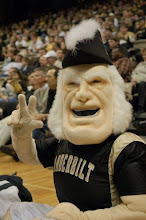Some of the programs included Tennessee and five others that were in the NCAA men's basketball tournament and two Bowl Championship Series entrants, Kansas and Hawaii, in football.
"Academic reform is here to stay. ... It's been in place now for four years," NCAA President Myles Brand said. "Everyone — coaches, ADs, presidents and student-athletes — should understand that's the order of the day."
According to the article, the programs "posted subpar academic progress rates (APRs), which have been computed by the NCAA for the last four years and hinge on retaining players, keeping them academically eligible and ultimately graduating them. Twenty-six teams — including 20 in the longtime problem sports of men's basketball, football and baseball — were flagged as chronic underperformers and handed stiffer penalties, including reductions in practice time."
Still, more than a third of the 329 Division I schools had at least one team penalized.
Two major-college football programs, Alabama at Birmingham and San Jose State, were docked nine scholarships each. Washington State and Idaho each lost eight.
Men's basketball, in particular, "remains a serious problem," Brand said.
53 programs were sanctioned, including 39 that drew scholarship cuts or practice restrictions. Tennessee lost one scholarship, as did Purdue, Kansas State and South Alabama, while Southern California lost two.
They were hit with the NCAA's first phase of penalties, given annually to programs with APRs below 925 (on a scale to 1000) and preventing them from replacing scholarship athletes who've left while academically ineligible.
The NCAA compiles APRs for every one of the 6,272 men's and women's sports teams in Division I. Points are awarded, player by player, and the association has determined that teams should hit 92.5% of their possible total — an APR of 925. That roughly projects a 60% graduation rate.
At the same time, there were 507 teams that posted APRs below 925 but didn't draw sanctions because they had no athletes who left school while academically ineligible or their schools sought and received waivers — granted by the NCAA when there are mitigating circumstances and the institution has an acceptable academic improvement plan.
Among those who received exceptions were LSU and Florida (men's basketball) and South Carolina (football).
"That raises the question: How can so many schools avoid sanctions?" said Nathan Tublitz, a neuroscience professor at Oregon who co-chairs the Coalition on Intercollegiate Athletics, an alliance of faculty senates at Division I universities. "One can understand a few exceptions. One can understand that some schools have good reasons. But for so many schools to have so many good reasons raises the question of whether there's really any bite to this academic performance package and the sanctions that are supposed to be issued."
Tublitz is a "very strong supporter" of the overall package, he said. "It's just that if you're going to set up a program that has a cutoff score, you have to stick to that cutoff score and not continue to give schools a free ride. If they don't make it after four years, what's going to happen after five? What's going to happen after six? How many times does a school get an exception?"
I couldn't agree more with Tublitz's assessment. I like the fact that the NCAA is making a commitment to academics, but if it's not going to follow through on its penalties, then it looks like its efforts are just for show.






No comments:
Post a Comment